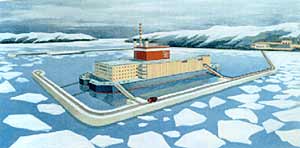The first Russian geothermal power plant is to be launched in Kamchatka tomorrow. A main opponent to this development is the Ministry for Nuclear Energy (Minatom), which is about to launch the world's first floating nuclear power plant at a nearby bay.
Mutnosky geothermal power plant (GPP) will be set in operation in Kamchatka, the Russian Far East, on December 20th. The first turbine’s capacity is 250 MW. In March 2002, with the second turbine launched, the power plant is to reach the capacity of 500 MW.
Geothermal plants make use of hot steam and water, obtained from the earth. This form of renewable sources of energy is widely used in the world. For example, Reykjavik, the capital of Iceland, has been exploiting geothermal waters for heating and industrial purposes since 1943. In Russia, Mutnovsky GPP will be the first plant of this kind.
Russians, who will work at Mutnovsky, have been trained in Germany at Siemens. The company supplied equipment for the plant. Building and pre-starting procedures are controlled by the Russian joint-stock company Unified Energy Systems of Russia (UESR).
To secure the environmental part of the project, the process flowsheet of Mutnovsky is provided with systems to pump condensed and saline waters back into the earth. The plant also has systems to deal with melting of snow and to prevent hydrogen sulphate releases into the atmosphere.
The European Bank lent money
The effective and environmentally appropriate project was created owing to a grant, provided by the European Bank for Reconstruction and Development (EBRD) in 1997. The implementation of the project was made possible in 1998 due to a EBRD loan of $99.9m.
But in the meantime, two weeks before the start date – December 20th – the Audit Chamber, a watchdog organisation appointed by parliament to oversee the federal budget, made a statement about financial violations at Mutnovsky.
The Chamber said that the disregard to the time terms of the loan caused builder’s debt to the Ministry for Finance. The debt has allegedly exceeded $3.1m.
According to the Chamber’s information, the EBRD loan is worked out for 34.7% (as of July 2001). Russian participants managed to contribute only 50% of their funding share, with $42.2m still missing.
Minatom assists on floating nuclear power plants
The main opponent to the Mutnovsky geothermal plant development is the Ministry for Nuclear Energy (Minatom), which is about to launch the world’s first floating nuclear power plant (NPP) at Krasheninnikov Bay near the closed city of Vilyuchinsk, the neighbour of Mutnovsky. The plant’s designed capacity is 70-80 MW, and the project’s cost is estimated to be in between $200m and $500m.
The Central Design Bureau Iceberg in St Petersburg is going to complete the standard design and feasibility study of the floating NPP in the first quarter of 2002. The main goal of the project builders is “not to raise noise among the public and envirogroups”.
Minatom makes no secret of the fact that it plans to sell the floating NPPs to the countries of the South-West Asia, Persian Gulf and North Africa. But the to be buyers do not want to verify safety of the first floating NPP on themselves. Thus Minatom plans to build it in Kamchatka first. The plant was at first planned for Chukotka’s town of Pevek, but Chukotka’s governer refused from this nuclear ‘gift’, while Kamchatka is not so financially independent from the federal centre, which Minatom represents.
Experts from Vilyuchinsk say the town has no need for nuclear reactors. On the contrary, Vilyuchinsk has to get rid of a dozen of retired nuclear submarines laid up there. The submarines, often with spent fuel onboard, are rusting only 24km away from the residential area. Now the need for their decommissioning is admitted by the officials, but the existing plans suggest only to cut out the reactor compartment and two adjacent compartments. No steps have been taken to unload spent nuclear fuel from the reactors. New floating NPP can only aggravate the situation.
The experts from Vilyuchinsk say that in two years, after all the units of Mutnovsky GPP are put into operation, Tolmachevo hydro-plant is built and gas pipeline is stretched to Petropavlovsk, the region will have excess energy. Floating NPPs are not only potentially dangerous; they generate additional radioactive waste and are simply not required in the area. Renewable energy of Mutnovsky geothermal plant solves the energy supply problems better, local environmental groups say.




